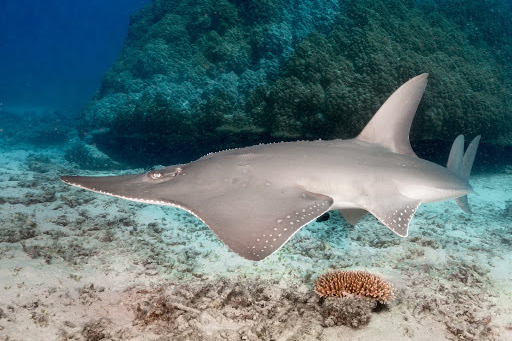What’s a wedgefish and why should we care?
 March 31, 2021
March 31, 2021
Wedgefish are awesome animals, and they are much loved by anglers and biologists because they are beautiful, rare, and fascinating. Their massive dorsal fins and flattened heads may have you wondering if they are sharks or rays. I hope this post inspires you discover and appreciate our wedgefishes and participate in ensuring their long term survival in Singapore waters. This post was inspired by the 20kg smooth-nose wedgefish (Rhynchobatuslaevis) that was caught at Singapore’s Bedok Jetty on 29 March 2021.

Wedgefishes have massive dorsal fins (like sharks) and flattened heads (like rays). So which are they? The diagram below shows the relationship between different groups of cartilaginous fish (Chondrichthyes). In humans, cartilage is the stuff that gives our ears and noses shape.
We can see that Wedgefishes (Rhinopristiformes) are more closely related to rays, than they are to sharks, and that they are in a group of their own! But why don’t these fish have bones?

Bones are really useful. They provide a strong internal structure for our muscles to adhere to, they produce red blood cells, and they prevent us from slumping onto the ground into a pile of goo. But if you were a big predator in the ocean hunting fast and agile fish or mammals, having a body made of cartilage is handy because you can bend your body at acute angles, and because cartilage is lighter than bone, you can accelerate faster in the water with less energy. Since water is a weightless environment (that’s why astronauts do their training in big swimming pools), cartilaginous fish don’t depend on internal bones to maintain their shape. Which brings us to our next point.
Cartilaginous fish don’t do very well outside of water. Without ribs, the weight of their bodies collapse onto and crush their internal organs, which can lead to internal bleeding and death. Wedgefishes don’t have to swim to breathe. The rhinobatid respiratory pump is an active process that wedgefish use to draw water through their mouths and over the gills. When held outside of water for too long, wedgefishes, like all their cartilaginous cousins, suffer from hypoxia because not only are they are not able to get oxygen into their blood, they are not able to get carbon dioxide out of their blood. Hypoxia can lead to brain damage. In wedgefishes, which are particularly sensitive to hypoxia, this can occur within minutes.
When wedgefishes are stressed, their bodies produce cortisol (just like us!). Cortisol encourages the body to release glucose into the blood, this allows the fish to give a “last hard fight” before it gets completely exhausted. The build up of cortisol and carbon dioxide in the body can take many hours to recover from. Because their bodies are exhausted, tired wedgefishes (and sharks) that are returned to the water will sink to the bottom (they are negatively bouyant). Unfortunately for most species, they will likely continue to suffocate because they can’t get water over their gills (Remember that wedgefishes need to actively pump water over their gills? This requires energy and muscular contractions). Bedok jetty is a popular fishing spot for anglers, but the design of the elevated platform makes it impossible to “ventilate” fish before release (as demonstrated in the video above), and challenging to safely return caught fish.

Wedgefishes have been a part of Singapore’s natural heritage for a long time, and have brought much delight to recreational fishermen. The gallery below are photos of wedgefishes caught off Bedok jetty between 2005 and 2020. Apart from the weights and sizes documented by fishermen, what else can we learn about these fish? Size can help us estimate their age. At about 1500mm, white-spotted wedgefishes are probably about 6 years old. Their growth rates start to slow down after 6 years, so at 2000mm length, they are not much bigger, but twice the age! Like whiprays, female wedgefish give birth to about 7-10 live young. Again, these fish don’t cope well with stress, and females are known to abort their fetuses‘ due to capture-induced stress.

Source: “Giant sawfish roped ashore off Changi Beach”, The Straits Times, 28 August 1975.
Wedgefishes can be found throughout the Indo-Pacific. Once thought to be one species, it is now understood to comprise four distinct species. White-spotted wedgefish are migratory and can be found in coastal inshore habitats in Southeast Asia and Australia. These bottom-dwelling fish spend their time on the seabed where they feed on benthic invertebrates, crustaceans and small bottom-dwelling fish. Below: A small gathering of white-spotted wedgefishes off Tioman Island, Malaysia.
Could Singapore seas serve as an important protected area for this globally threatened species? Could we introduce a wet platform from which fishermen at Bedok jetty could safely remove the hooks from their fish without having to haul the fish vertically from the water? (which leads to the animal being out of the water for longer lengths of time) A wet platform could also allow fish that are about to be released to be “ventilated” before they are released. Supporting fishing infrastructure can save fish. These fish are worth saving because they are awesome and enrich the lives of many. However, they are slow growing, late to reach reproductive maturity and when they do mature, they produce very few young. Compounding their biological vulnerability, wedgefish live in coastal habitats, which make them easier to catch from shore as well as being extremely vulnerable to multiple gear types. The large size of their fins, which are valued among the highest in trade means that even when wedgefish are caught as bycatch they are kept and sold. With so many odds stacked against them, every fish we can safely return to the sea, would represent hope for the species, and joy for future generations of divers and fishermen. Learn more.
Thanks to Christina Choy for identifying the species of wedgefish that was caught at Bedok jetty.
 Posted in
Posted in 



 content rss
content rss
COMMENTS